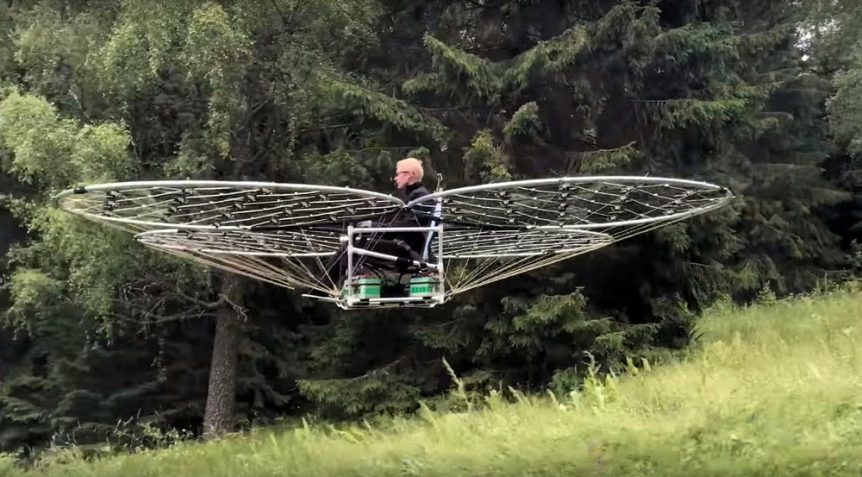New Atlas (formerly Gizmag) alerted your editor to this web site, which in turn features over a score of YouTube videos on this fascinating project in Sweden. Axel Borg has created, as promised by the web site, an Amazing DIY Project, flying around a hilly woodland on the power of 76 electric motors. Undaunted by Fuel Fumes or Crashes More amazing, perhaps, he tried this configuration a year ago with eight internal combustion engines (extremely noisy), but managed to crash that. Resisting the fear that would instill in queasier souls (your editor, for instance), Axel made four tubular rings, within each of which is mounted a set of 19 motors. The four rings surround the pilot’s seat, under which are mounted four battery packs – each one supplying a set of motors with power. Axel has apparently done a good job of managing the control of the machine, showing in several videos his ability to maneuver in roll, pitch and …
54 Rotors, Nine Autopilots, and One Human Pilot
A man identified only as JetTurbine101 on his YouTube channel has been test flying a 54-propeller multi-rotor craft for the last year. We see it evolving from back-yard flying to more open-air, higher moments in the videos below. His August 29, 2015 video includes the most detailed description of the Swarm man-carrying device so far. JetTurbine man groups its counter-rotating propellers into six control channels with KK2.15 stabilization, the KK2 unit being a miniature autopilot normally used on model hobby craft. The aircraft has a takeoff weight of 148 kilograms (325.6 pounds) and a claimed maximum lift of 164 kilograms (360.8 pounds). Its combined motor power of approximately 22 kilowatts (29.5 horsepower) runs the battery pack down in 10 minutes. He says the machine is, “Just a bit of fun for myself, never intended for making a significant journey or flying much above head height.” The Swarm’s approximate cost is £6000 ($9,180). He explains the Swarm’s layout, partly as a …
Would You Believe There Are Four Electric Cri-Cri’s?
Three electric MC-15 Colomban Cri-Cri’s have been flying for at least the last two years. Jean-Luc Soullier created one which flew with Plettenberg model motors. Airbus crafted one with four Rotex motors and counter-rotating propellers on each mount. Anne Lavrand’s Electravia converted a Cri-Cri to use her motors for speed record attempts. Now they are joined by the MC-15E built by Mr. Toon Jacobs and shown at the Federation RSA ( Network of Sport Air ) Rally 2013 in Vichy, France. The RSA, as one would guess, is the French equivalent of America’s Experimental Aircraft Association (EAA). Electravia provided the E-Motor GMPE 104 motors, controllers, E=Helices 370 gram (one pound, 13 ounces), 83 centimeter (32.7 inches) propellers and the E-Batts 3 kilowatt-hour battery pack. An Electravia E-Screen instrument monitors battery charge, temperature, and motor temperatures. Powerplants match those developed in 2010 for Cri-Cri Yankee Delta in which Hugues Duval set a world speed record for electric aircraft before a huge crowd at the 2011 Paris Air …
Electric Gull Flies at Arlington
The annual fly in at Arlington, Washington was an electric landing zone for Mark Beierle’s Gull 2000, powered by his own design 20-kilowatt motor. The 36-coil, 42 magnet disk, weighing 16 pounds, is mounted on a truss arrangement behind the airplane’s high wing, and drives a ground-adjustable pusher propeller. Flying five half-hour demonstration flights during the half-week event accounted for almost half the six hours total time on the airplane so far. The airplane has a 74-Volt Rhino Lithium-polymer battery pack made up to 11 packs in a parallel/series arrangement. Beierle says this array, and taking voltage from the ends of each 3.7-Volt series pack, allows balancing of all 210 cells. Power is run through a 500-Amp Kelly controller, which weighs about 12 pounds: Beierle hopes to try a new Kelly unit which will be half that weight and less expensive. Battery protection is provided by circuits in the charger, which will be the same Kelly unit Beierle uses in recharging his …

